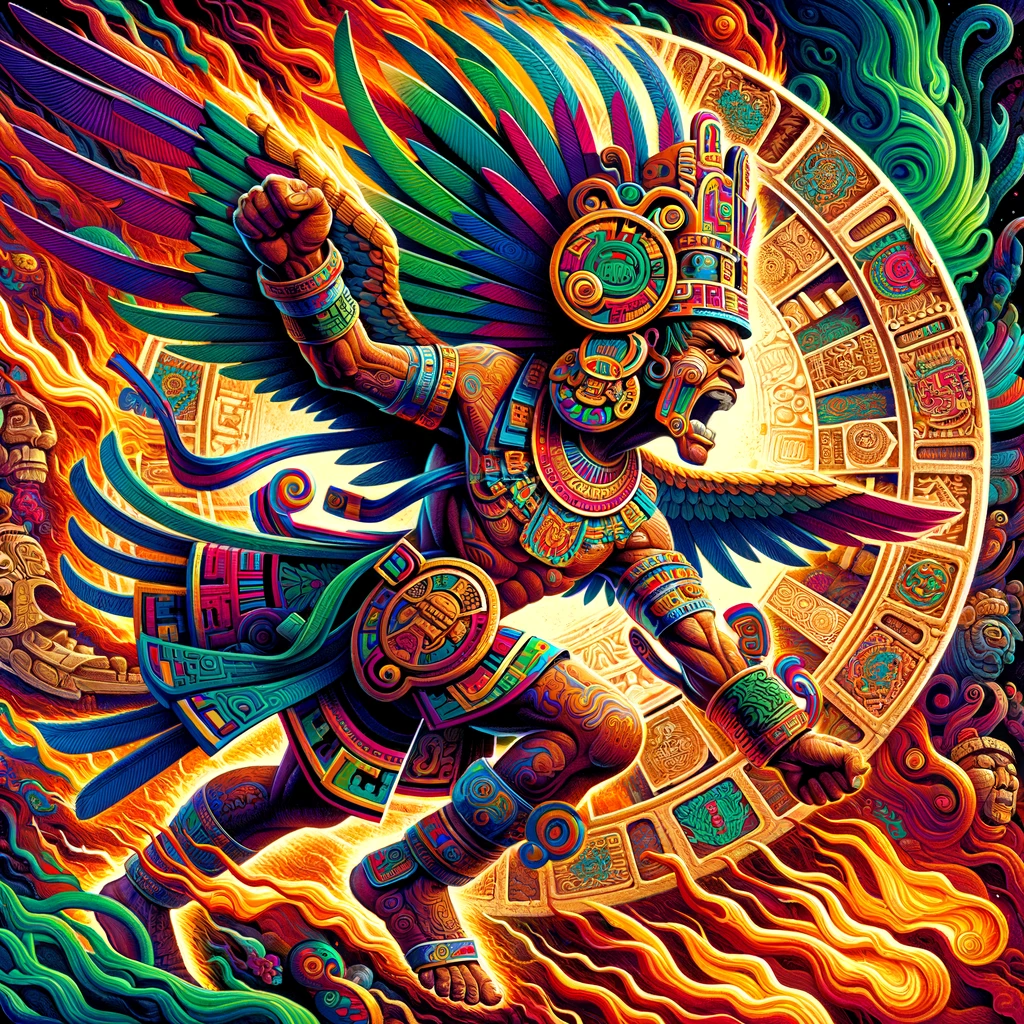
In the rich tapestry of Aztec mythology, few deities capture the imagination as vividly as Xiuhtecuhtli, the god of fire. Known as the 'Turquoise Lord' or 'Lord of Fire,' Xiuhtecuhtli occupied a central place in the Aztec pantheon, embodying both the creative and destructive aspects of fire. His influence extended over heat, light, and life, signifying the dynamic interplay of these fundamental forces in the Aztec understanding of the world.
Origins and Symbolism
Xiuhtecuhtli, whose name combines the Nahuatl words for 'year' (xiuh) and 'lord' (tecuhtli), was not only a god of fire but also a symbol of time and aging. He was often depicted as an aged deity, embodying the wisdom and experience of the old. In iconography, he is frequently portrayed with a red or yellow face, with turquoise encrustations, and an adornment of paper flags. This representation linked him to the precious stone turquoise, revered in Aztec culture, and to the ephemeral nature of paper, a symbol of fleeting time.
Cultural Significance
The importance of Xiuhtecuhtli in Aztec society cannot be overstated. Fire was central to Aztec life, not just in practical terms for cooking and warmth, but also spiritually. It symbolized the sun, the ultimate source of life, and was seen as a portal to the divine. Xiuhtecuhtli, thus, was a mediator between the earthly and the divine, a guardian of the eternal flame that connected the two realms.
Festivals and Worship
Xiuhtecuhtli was celebrated in various festivals, most notably during the New Fire Ceremony, or Toxhiuhmolpilia, held every 52 years. This ritual marked the end of a calendar cycle and was meant to ensure the rebirth of the sun and the continuation of the world. The ceremony involved extinguishing all fires in the Aztec realm, symbolizing the death of the old world, followed by the lighting of a new fire by the priests of Xiuhtecuhtli, signifying rebirth and renewal.
Interactions with Other Deities
In the intricate web of Aztec mythology, Xiuhtecuhtli interacted with various other deities. He was often associated with Huehueteotl, another fire god, and was considered the husband of Chalchiuhtlicue, the goddess of water, highlighting the essential balance between fire and water. Furthermore, he was one of the nine Lords of the Night and was particularly linked to the first hour of night.
Legacy and Modern Relevance
The legacy of Xiuhtecuhtli extends beyond ancient Aztec civilization. In contemporary Mexican culture, elements of his worship and symbolism can be traced in various cultural practices and beliefs. He remains a potent symbol of creation and destruction, embodying the ever-present power of fire in both its nurturing and devastating forms.
In conclusion, Xiuhtecuhtli, the Aztec Lord of Fire, stands as a testament to the complexity and depth of Aztec mythology. As a deity encompassing creation, destruction, time, and renewal, he offers a fascinating glimpse into the spiritual landscape of one of history's most intriguing civilizations.
Origins and Symbolism
Xiuhtecuhtli, whose name combines the Nahuatl words for 'year' (xiuh) and 'lord' (tecuhtli), was not only a god of fire but also a symbol of time and aging. He was often depicted as an aged deity, embodying the wisdom and experience of the old. In iconography, he is frequently portrayed with a red or yellow face, with turquoise encrustations, and an adornment of paper flags. This representation linked him to the precious stone turquoise, revered in Aztec culture, and to the ephemeral nature of paper, a symbol of fleeting time.
Cultural Significance
The importance of Xiuhtecuhtli in Aztec society cannot be overstated. Fire was central to Aztec life, not just in practical terms for cooking and warmth, but also spiritually. It symbolized the sun, the ultimate source of life, and was seen as a portal to the divine. Xiuhtecuhtli, thus, was a mediator between the earthly and the divine, a guardian of the eternal flame that connected the two realms.
Festivals and Worship
Xiuhtecuhtli was celebrated in various festivals, most notably during the New Fire Ceremony, or Toxhiuhmolpilia, held every 52 years. This ritual marked the end of a calendar cycle and was meant to ensure the rebirth of the sun and the continuation of the world. The ceremony involved extinguishing all fires in the Aztec realm, symbolizing the death of the old world, followed by the lighting of a new fire by the priests of Xiuhtecuhtli, signifying rebirth and renewal.
Interactions with Other Deities
In the intricate web of Aztec mythology, Xiuhtecuhtli interacted with various other deities. He was often associated with Huehueteotl, another fire god, and was considered the husband of Chalchiuhtlicue, the goddess of water, highlighting the essential balance between fire and water. Furthermore, he was one of the nine Lords of the Night and was particularly linked to the first hour of night.
Legacy and Modern Relevance
The legacy of Xiuhtecuhtli extends beyond ancient Aztec civilization. In contemporary Mexican culture, elements of his worship and symbolism can be traced in various cultural practices and beliefs. He remains a potent symbol of creation and destruction, embodying the ever-present power of fire in both its nurturing and devastating forms.
In conclusion, Xiuhtecuhtli, the Aztec Lord of Fire, stands as a testament to the complexity and depth of Aztec mythology. As a deity encompassing creation, destruction, time, and renewal, he offers a fascinating glimpse into the spiritual landscape of one of history's most intriguing civilizations.